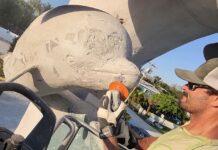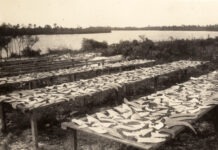Telling a pirate story in the Florida Keys and passing a joint around an island party have one big thing in common. Both are shared with a rapt audience.
Sparking up either one — be it the conversation or the joint — has been known to reveal the other. Sadly, however, the two things have one glaring difference.
The island chain boasts a rich history connected to marijuana and drug smuggling.
But as it turns out, documented pirate stories from the old days that can be connected to the Florida Keys are pretty few and far between. Digging deeper into the local history, what becomes clear is that most of the stories told about pirates in the Florida Keys have about the same structure and substance as those wispy tendrils of smoke swirling up from the bright, hot cherry burning at the tip of a joint.
Still, the Keys have an interesting relationship with pirate history. Locals will insist that pirates and piracy are alive and well and that they always have been. They have a point. The Keys have a long history of pirate-related activity. After all, Commodore David Porter and the West Indies Squadron, the anti-piracy unit in charge of clearing the local waters of their ilk, established their headquarters at Key West in 1823. The location was not chosen by accident.
Fact or fiction, pirates and piracy will always be inexorably connected to the Keys, or at least to the adjacent waters. Volume 2 of my series “Florida Keys History with Brad Bertelli” is filled with stories about the kind of old-fashioned piracy that once ruled the West Indies and inspired the United States government to create a special anti-piracy force. Modern piracy involving square groupers and the rampant drug smuggling of the 1970s and 1980s will be stories told another day.
Volume 2 is dedicated to exploring the arrival of Porter’s West Indies Squadron, its mission to eliminate the threat of piracy in the local waters, and a collection of bona fide pirate stories connected to the island chain (even if, in some cases, peripherally). However, the book’s primary focus is exploring the legend and lore of the undisputed pirate king of the Florida Keys, Black Caesar.

A couple of years ago, when I started playing around with the idea of Black Caesar as an extended story — perhaps even a book — I set the stories up to mirror a book I published in 2021 called “The Florida Keys Skunk Ape Files.” The Skunk Ape is Florida’s Bigfoot, and the book is based on an actual sighting of the cryptid on Key Largo in 1977. The event garnered national attention, including a story featured in the National Enquirer. It also appeared in several editions of the local newspapers.
For that book, I created a fictional group called the Southernmost Skunk Ape Society, whose often stoned members investigated a collection of Skunk Ape events that were discovered in a series of manila file folders found inside two dusty banker’s boxes. In their pot-smoking defense, the story does take place in 1977 and mainly in Key West, so that behavior almost seems expected.
When I started working on this book, I initially envisioned it as The Black Caesar Files, and it was the fictional Black Caesar Society that would investigate all the different legends and lore surrounding the pirate. Eventually, it became clear that the pirate’s stories should be shaped by the people who had been writing about him (them) for more than a century — and wow, there are some doozies. The fun of the book is in all the nooks and crannies, all the twists and turns the pirate’s story takes.
But then, I started my Facebook group, Florida Keys History with Brad Bertelli (check it out if you have not already). Because of its surprising popularity, I was inspired to create a book series based on my research into the local island histories. I knew from the beginning that Volume 2 would be filled with stories about pirates, piracy and most importantly, Black Caesar’s wild, wild story.
During my deep dive into his history, five men have been identified as Black Caesar, and all of them can be linked to Elliott Key — though one just tangentially. It was on Elliott Key, in the northern Keys, that the pirate allegedly established his lair and commanded the Straits of Florida, century after century — hence his legendary status.
In addition to placing a magnifying glass in front of all the stories, and to the slew of characters connected to South Florida and the Keys who have added to the pirate’s lore, Volume 2 tells a legendary story that will have a surprise or two for even the most ardent fan of piracy and the Florida Keys.
If you have not yet picked up your copy of “Florida Keys History with Brad Bertelli Volume 2,” signed copies are available at the Florida Keys Visitor Center and Shell World, both in Key Largo; Sandbar Books in Tavernier; the Kayak Shack at Islamorada’s Robbie’s Marina; and Key West Island Books at 513 Fleming St.
If you are a retailer interested in carrying my titles, please reach out. While my books are also available through Amazon, if you are here in the Keys, please shop local.


























